Comparing Characteristics of Environmental Behaviors and Spatial Types in Open and Gated Housing Blocks: A Case Study of Changchun, China
Abstract
1. Introduction
1.1. General Context and Its Peculiarities
1.2. The Purpose of this Work and Its Significance
1.3. Research Status
1.4. Controversial and Diverging Definitions
2. Materials and Methods
2.1. Identification of Case Studies
2.2. Investigation of Activities in Outdoor Spaces by the Place-Centered Behavior Mapping Method
2.3. Data Processing
3. Results
3.1. Characteristics of Residents’ Behaviors
3.2. Spatial Types Analysis According to Classification of Elements in Outdoor Spaces
3.2.1. Classification of Space Elements
3.2.2. Classification of Space Types
3.3. The Distribution of Behaviors in Space Types
4. Discussion
5. Conclusions
- (1)
- In the staying activities, which is more related to the space, [sitting and chatting] has the highest frequency in both open housing block CKB and gated housing block Q34, but the number in Q34 is more than twice as in CKB. As the CKB have in common with the Q34 population and area, this phenomenon is presumed to be associated with a significant difference of two housing blocks, open–closed state.
- (2)
- After the factor analysis of space elements in two housing blocks, it is known that influencing factors in open housing block are “near unit buildings”, “openness and closure of spaces” and “boundary and closure of spaces”, while influencing factors in gated housing block are “near unit buildings” and “openness and closure” only. Therefore, the spatial classification will be more explicit and steady in the latter. In the subsequent cluster analysis, the CKB and the Q34 were divided into four and three main spatial types, respectively. In particular, Co14, To2 of CKB was distinguished from other Co areas to be an independent type because dismantling boundary walls changed the elements of this region.
- (3)
- By analyzing the distribution of residents’ behavior in space types, we can see that, in CKB, the frequently occurring locations of the four main activities are scattered in the various types of To1, T3, and To4. In these types, Ao13, Bo6, and especially Co13 appear many times. These areas are located at the boundary of the residential area, the road node of the residential area and the position of the unit front road of the residential center. However, there is a more dramatic situation in Q34; all high frequency locations of activities belong to Tg1, of which Cg7, Cg15, and especially Bg6 should be paid attention. These areas are located in the front road of unit buildings, and two of them have three solid interfaces, with a strong sense of space and privacy.
Author Contributions
Acknowledgments
Conflicts of Interest
References
- National Bureau of Statistics of China (NBSC). China Statistical Yearbook 2017; National Bureau of Statistics of China: Beijing, China, 2017; Volume 4.
- Liu, X.; Liu, H.; Chen, W.; Zhang, Z. Spatiotemporal Fragmentation of Urban Residential Land Use: A Case Study from China. Sustainability 2017, 9, 1096. [Google Scholar] [CrossRef]
- Zhou, X.; Chen, X.; Zhang, T. Impact of Megacity Jobs-Housing Spatial Mismatch on Commuting Behaviors: A Case Study on Central Districts of Shanghai, China. Sustainability 2016, 8, 122. [Google Scholar] [CrossRef]
- Yang, S.; Hu, S.; Li, W.; Zhang, C.; Torres, J. Spatiotemporal Effects of Main Impact Factors on Residential Land Price in Major Cities of China. Sustainability 2017, 9, 2050. [Google Scholar] [CrossRef]
- Zheng, Q.; He, S.; Huang, L.; Zheng, X.; Pan, Y.; Shahtahmassebi, A.R.; Shen, Z.; Yu, Z.; Wang, K. Assessing the impacts of Chinese Sustainable Ground Transportation on the dynamics of urban growth: A case study of the Hangzhou Bay Bridge. Sustainability 2016, 8. [Google Scholar] [CrossRef]
- Miao, P. Deserted streets in a jammed town: The gated community in Chinese cities and its solution. J. Urban Des. 2003, 8, 45–66. [Google Scholar] [CrossRef]
- Sun Scale and Borders: A Reflection on the Enclosed Neighborhoods on the Periphery of Chinese Cities [Chidu Yu Bianjie: Fansi Zhongguo Chengshi Bianyuan Fengbishi Zhuzhaiqu]. Beijing Plan. Rev. 2007, 1, 136–141.
- World Bank; Development Research Center of the State Council, the People’s Republic of China. Urban China: Toward Efficient, Inclusive, and Sustainable Urbanization; World Bank: Washington, DC, USA; Development Research Center of the State Council, the People’s Republic of China: Beijing, China, 2014; ISBN 9781464802065. Available online: https://www.worldbank.org/content/dam/Worldbank/document/EAP/China/WEB-Urban-China.pdf (accessed on 17 February 2018).
- Central Committee of the Communist Party of China. State Council Issues Some Guidelines to Further Reinforce the Management of Urban Planning and Construction [Zhonggong Zhongyang Guowuyuan Guanyu Jinyibu Jiaqiang Chengshi Guihua Jianshe Guanli Gongzuo De Ruogan Yijian]. Xinhua News Agency, 6 February 2016. [Google Scholar]
- Gehl, J. Life between Buildings—Using Public Space; Arkitektens Forlag: Hørsholm, Denmark, 1996; p. 174. [Google Scholar]
- Alexander, C. A Pattern Language; Oxford University Press: Oxford, UK, 1977. [Google Scholar]
- Jacobs, J. The Death and Life of Great American Cities, Reissue edition; Vintage: New York, NY, USA, 1992; ISBN 067974195X. [Google Scholar]
- Gehl, J. Public Spaces—Public Life—for the 21st Century; The Danish Architectural Press: Copenhagen, Denmark, 2007. [Google Scholar]
- Kan, H.Y.; Forsyth, A.; Rowe, P. Redesigning China’s superblock neighbourhoods: Policies, opportunities and challenges. J. Urban Des. 2017, 22, 757–777. [Google Scholar] [CrossRef]
- Zhao, W.; Zou, Y. Un-gating the gated community: The spatial restructuring of a resettlement neighborhood in Nanjing. Cities 2017, 62, 78–87. [Google Scholar] [CrossRef]
- Sun, G.; Webster, C.; Chiaradia, A. Ungating the city: A permeability perspective. Urban Stud. 2017. [Google Scholar] [CrossRef]
- Xinhua News. China Outlines the ‘Blueprint’ for Future Urban Developments [Zhongguo Gouhua Weilai Chengshi Fazhan ‘Luxiantu’]. Xinhua News, 21 February 2016. [Google Scholar]
- Gao, L.; Cui, S.; Yang, D.; Tang, L.; Vause, J.; Xiao, L.; Li, X.; Shi, L. Sustainability and Chinese urban settlements: Extending the metabolism model of emergy evaluation. Sustainability 2016, 8, 459. [Google Scholar] [CrossRef]
- Daily, G. How Difficult Will it be to Open Enclosed Neighborhoods? there Ought to be a Transitory Phase [Fengbi Xiaoqu Kaifang Shixing Nandu You Duo Da? Ying You Guoduqi]. Guangzhou Daily, 23 February 2016. [Google Scholar]
- Han, J.; Wang, Y.B. Opening Neighborhoods isn’t Simply a Case of ‘Tearing Down Walls and Opening Compounds’, Complementary Suite of Policies and Amenities also Needed [Kaifang Xiaoqu Bu Jin Shi ‘Chai Qiang Po Yuan’, Xu Peitao]. Xinhua News, 23 February 2016. [Google Scholar]
- Wu, W. Vice-Minister of Housing and Urban-Rural Development: To Open Enclosed Neighborhoods is to Open the Gates and Not Demolish the Walls [Zhujianbu Fubuzhang: Dakai Fengbi Xiaoqu Shi Kai Men Bu Shi Chai Qiang]. Beijing News, 1 April 2016; 13–15. [Google Scholar]
- Logan, J.R. Urban China in Transition; Blackwell Publishing Ltd.: Hoboken, NJ, USA, 2008; ISBN 9781405161459. [Google Scholar]
- Giroir, G. The Purple Jade Villas (Beijing): A Golden Ghetto in Red China; Glasze, G., Webster, C., Frantz, K., Eds.; Routledge: Abingdon, UK, 2005. [Google Scholar]
- Wu, F.; Webber, K. The rise of foreign gated communities in Beijing: Between economic globalization and local institutions. Cities 2004, 21, 203–213. [Google Scholar] [CrossRef]
- Jan Gehl, B.S. How to Study Public Life; Island Press: Washington, DC, USA, 2013; ISBN 9781610915250. [Google Scholar]
- Graumann, C.F. The Phenomenological Approach to People-Environment Studies. In Handbook of Environmental Psychology; John Wiley & Sons: Hoboken, NJ, USA, 2003; ISBN 0471405949. [Google Scholar]
- Li, Z.; Munemoto, J.; Yoshida, T. Analysis of Behaviors along the Waterside in a Chinese Residential Quarter. J. Asian Archit. Build. Eng. 2011, 10, 85–92. [Google Scholar] [CrossRef]
- Haiwen, L. Concept and charactristics of communication space on community road. J. Shanghai Jiaotong Univ. 2013, 31, 51–57. [Google Scholar] [CrossRef]
- Dai, Y. The Thinking and Research of Residential Exterior Space form in China; Tianjin University: Tianjin, China, 2007. [Google Scholar]
- Zhang, J. Public Space in Walled Community; Tongji University: Shanghai, China, 2008. [Google Scholar]
- Chai, Y.W.; Ta, N.; Mao, Z.D. Urban Spatial Reconstruction in Cities in China from the Perspective of Danwei. Mod. Urban Res. 2011, 26, 5–9. [Google Scholar]
- Sun, L.; Luo, X.; Huang, J. Study on Outdoor Spatial Morphology and Communication Behavior in Determinant Danwei Community. Mod. Urban Res. 2017, 25–30. [Google Scholar] [CrossRef]
- Zhang, C.; Chai, Y. Un-gated and integrated Work Unit communities in post-socialist urban China: A case study from Beijing. Habitat Int. 2014, 43, 79–89. [Google Scholar] [CrossRef]
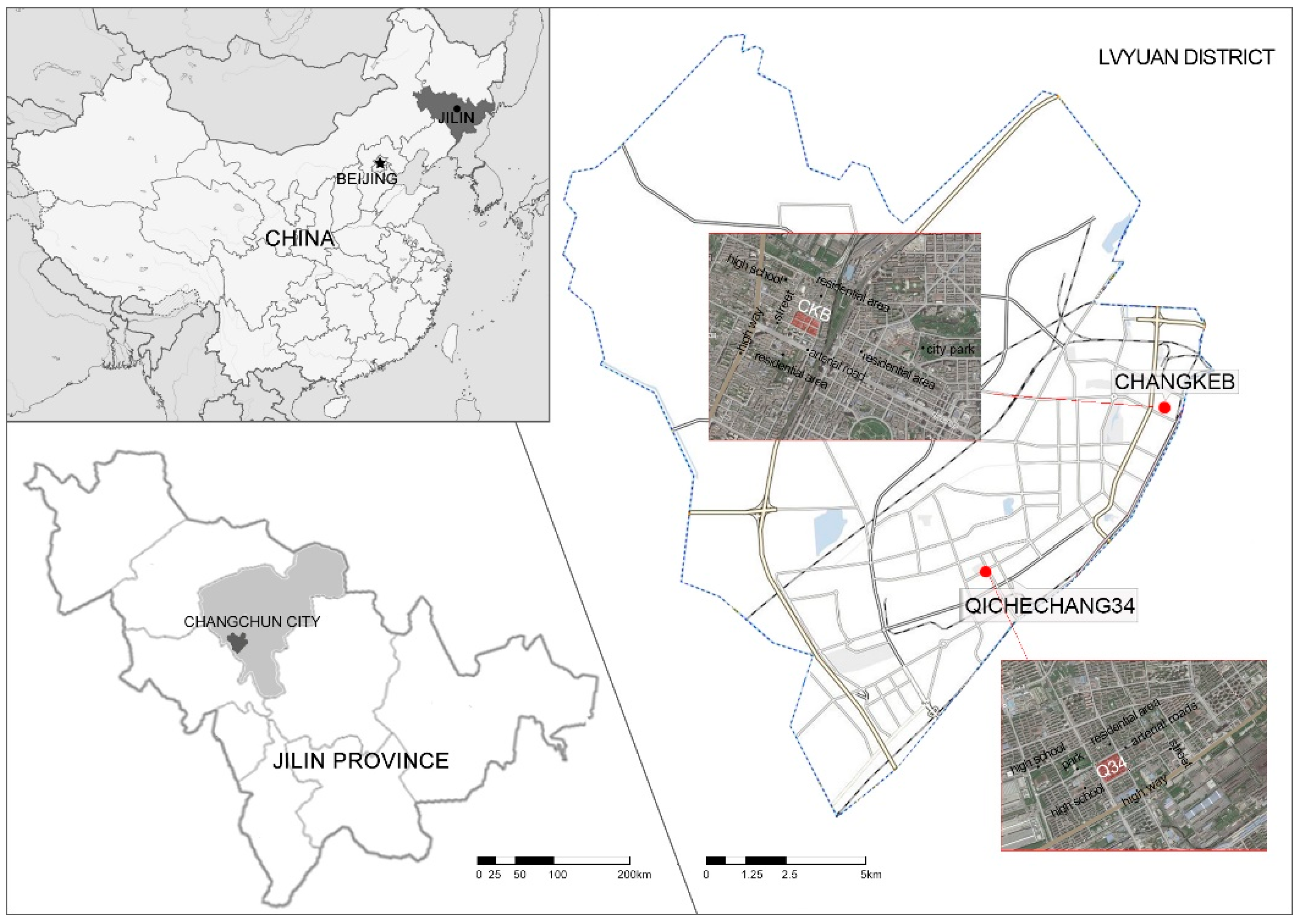
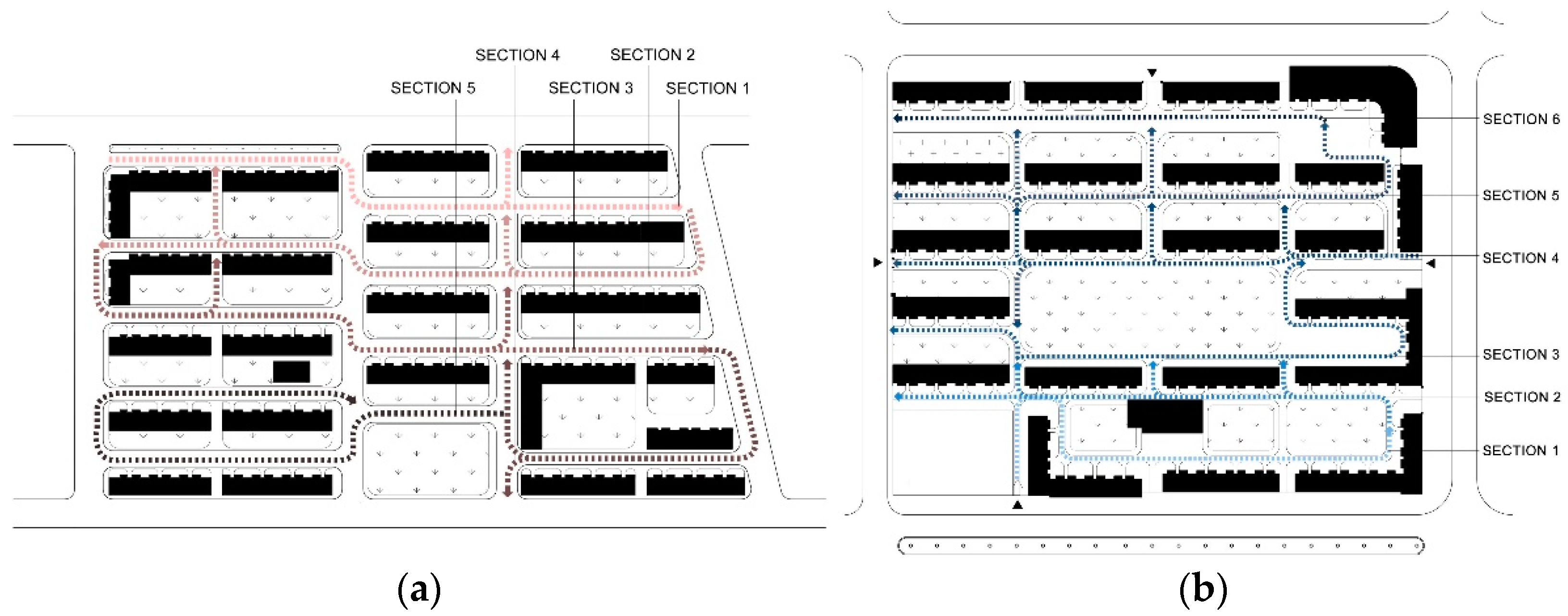
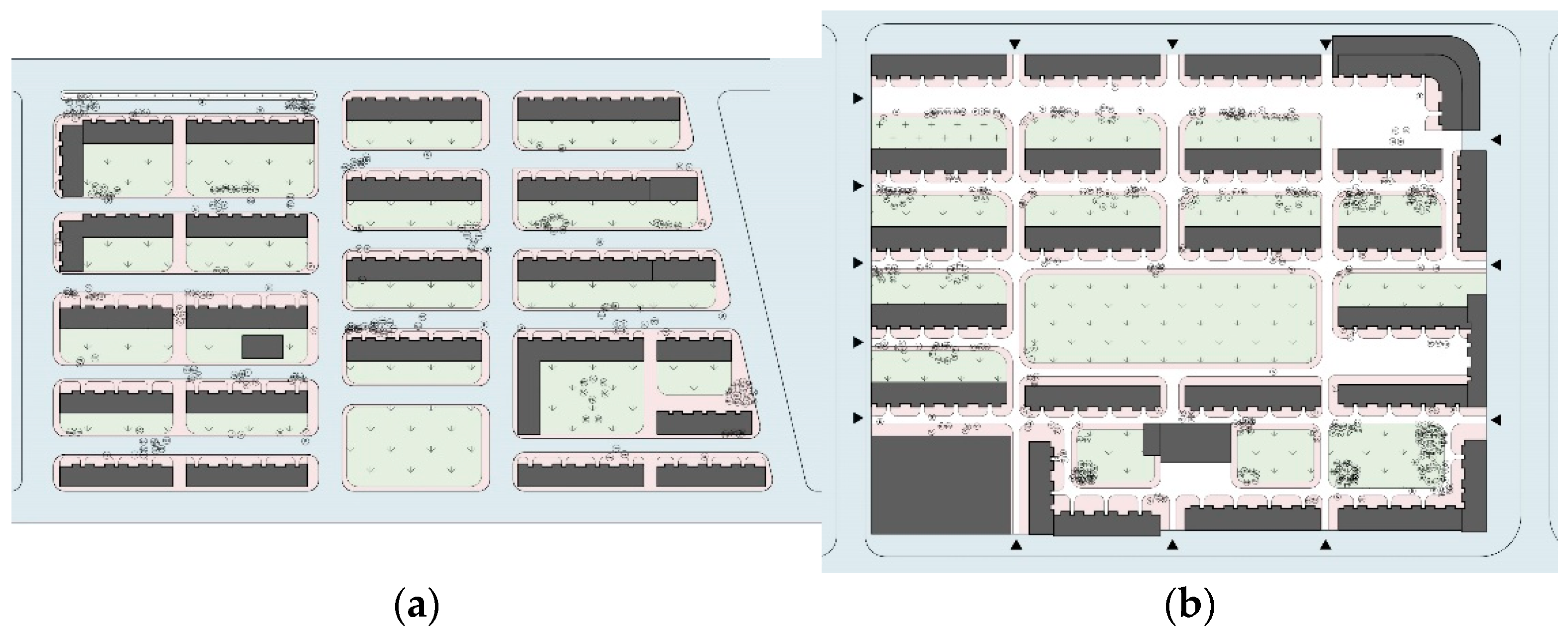
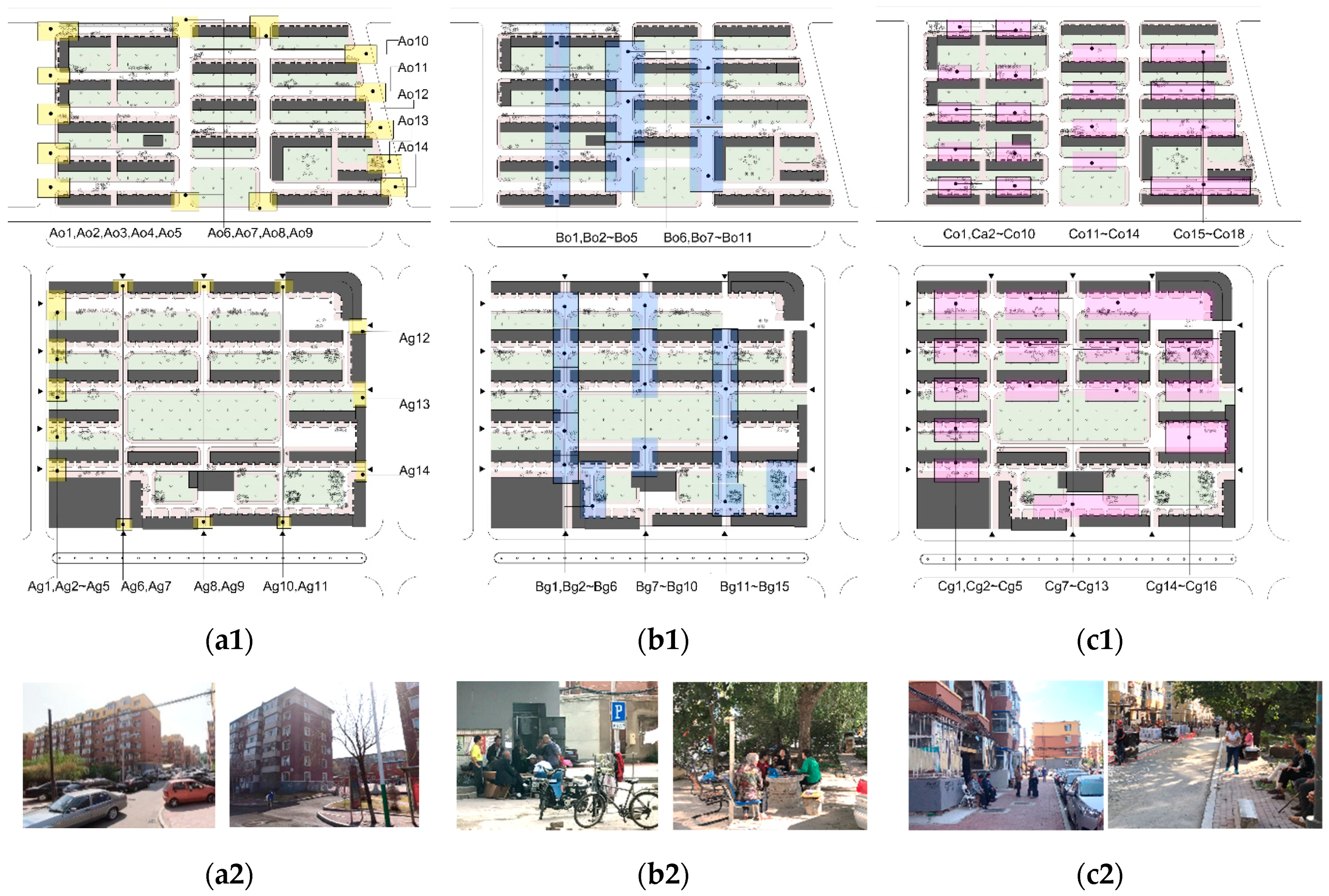
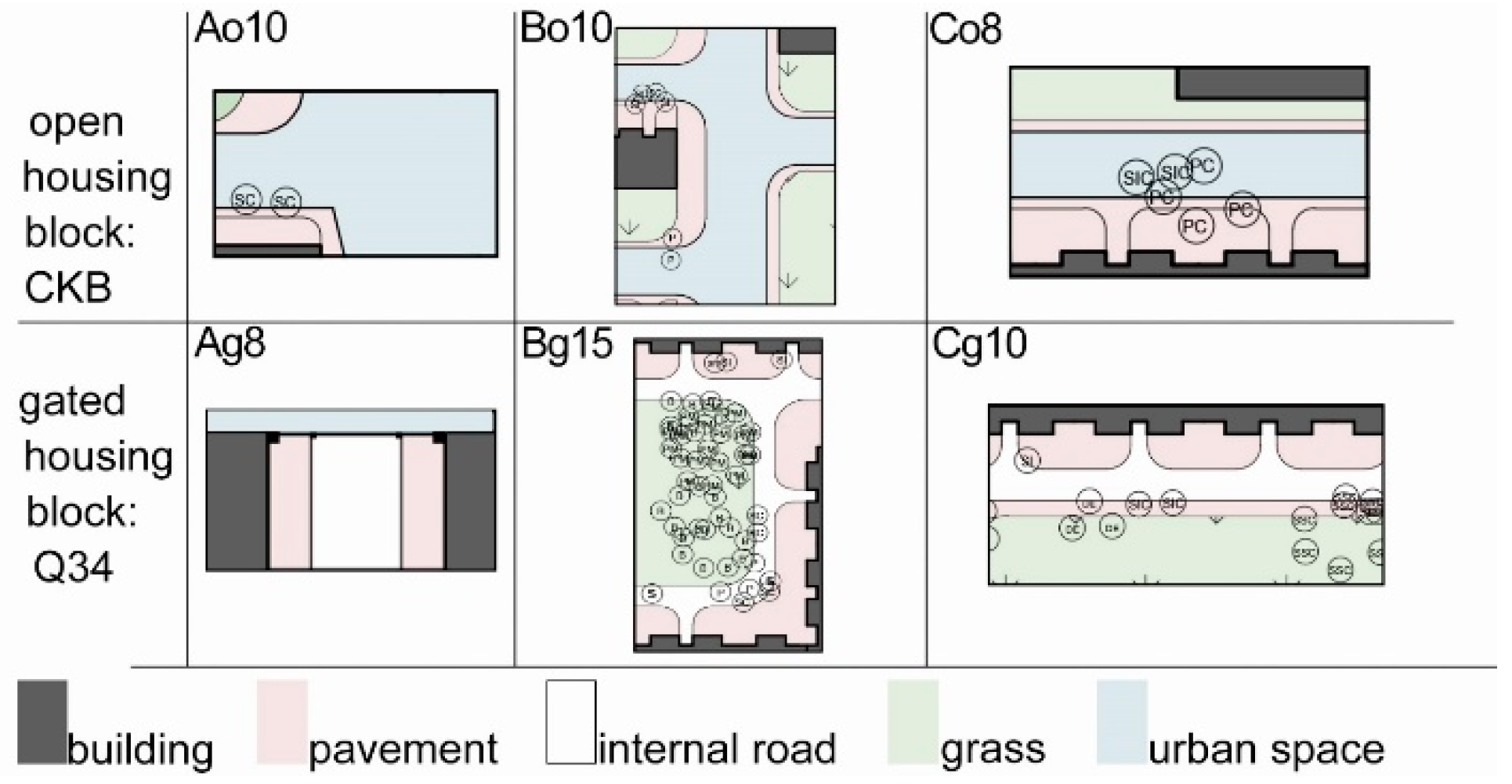
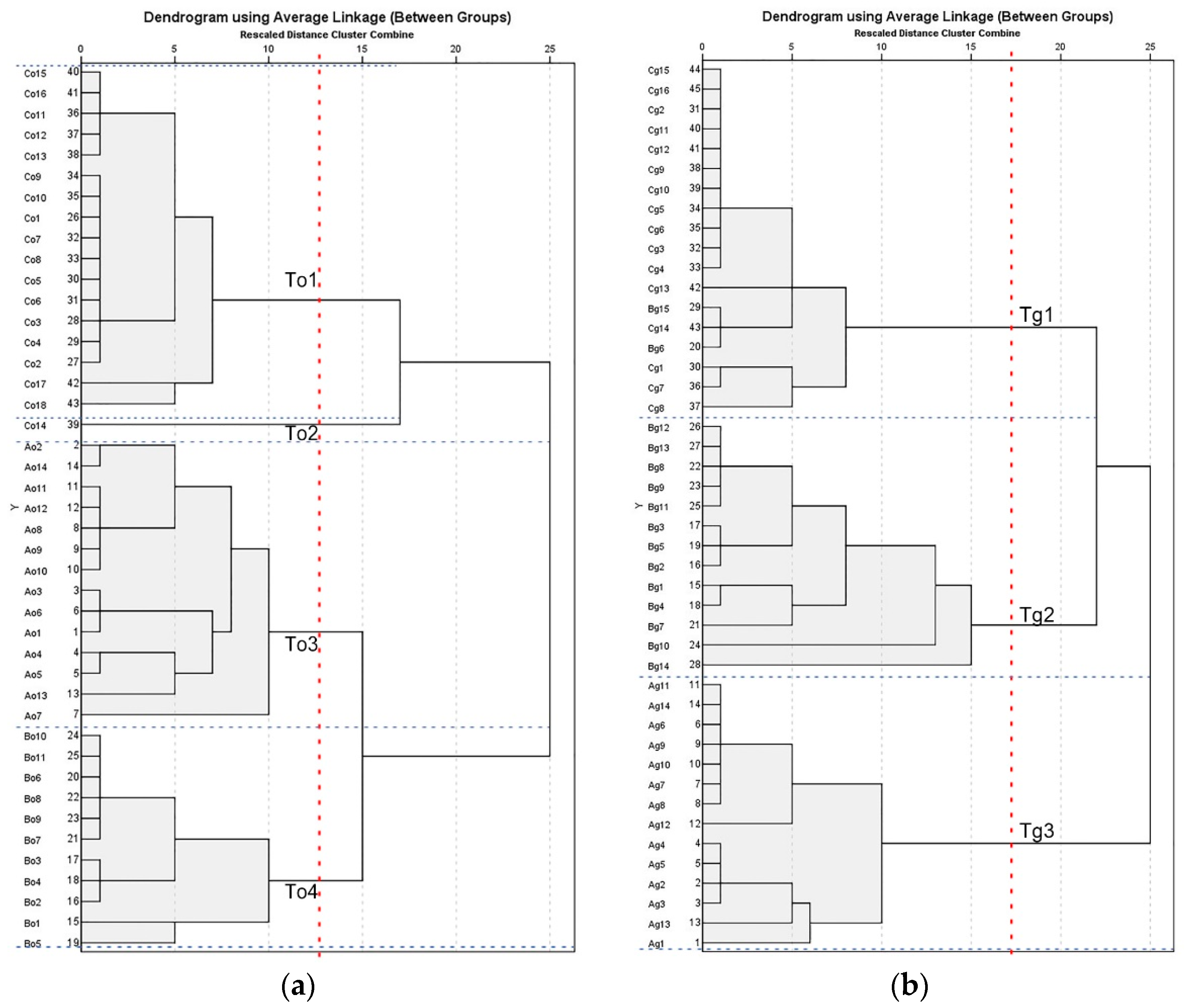
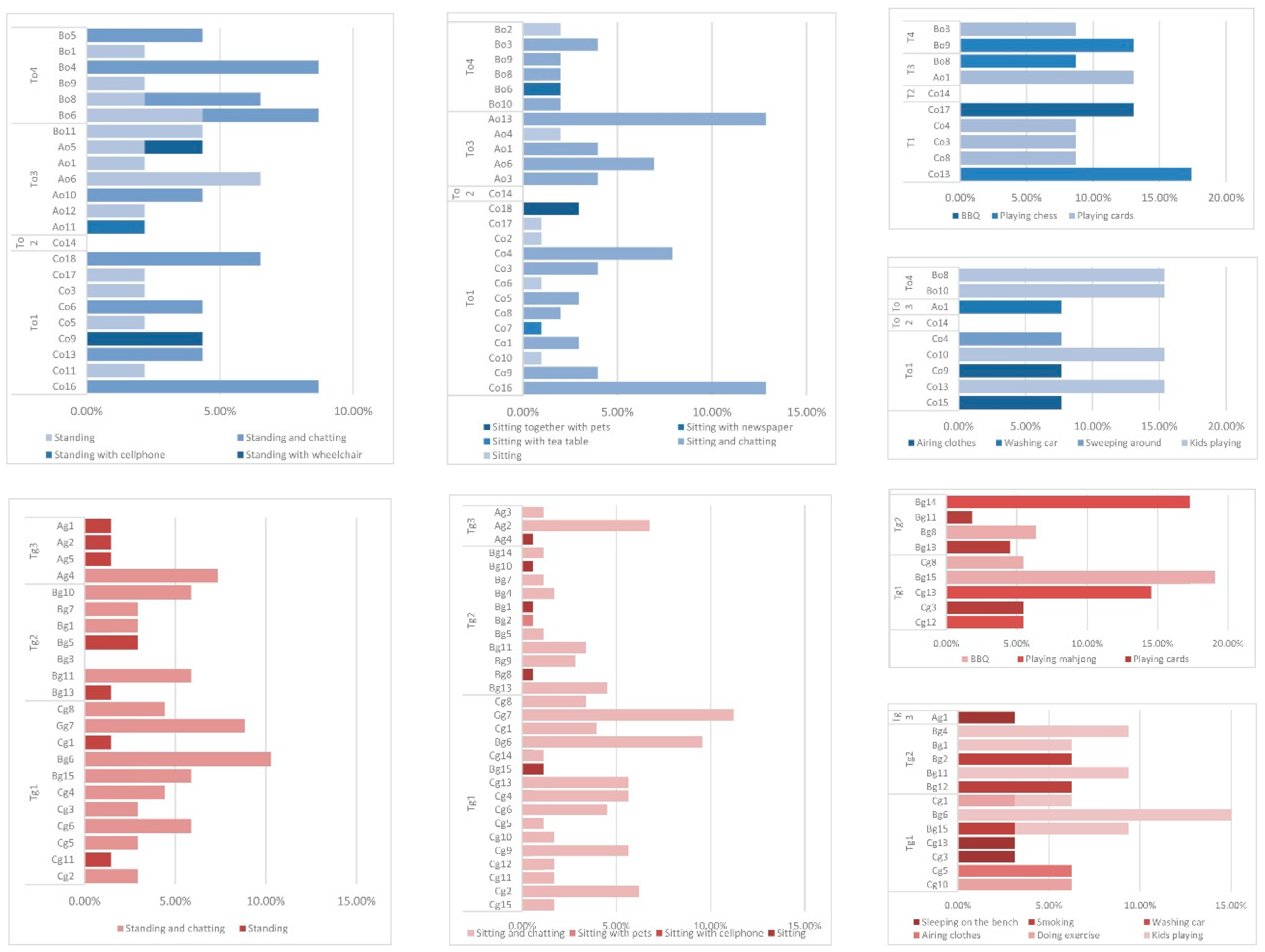
| Name | open housing block: CKB | gated housing block: Q34 |
| Location | Lvyuan District | Lvyuan District |
| Area | 60,952 m2 | 83,430 m2 |
| Age | completed in 1988 | completed in 1985 |
| Story | 6~7 | 6~7 |
| Building Amount | 21 | 22 |
| Household | 1140 | 1300 |
| Population | 3100 | 3541 |
| The Aged | 28.4% | 29.7% |
| Residents | employees of Changke factory | employees of the Yiqi factory |
| Behavior Frequency in CKB | ||||
| Non-Staying Activities | Cycling | 37 | 141 | |
| Passing by | 94 | |||
| Walking dog | 10 | |||
| Walking baby | 33 | 78 | ||
| Walking together | 45 | |||
| Staying Activities | Standing activities | Standing | 17 | 46 |
| Standing and chatting | 25 | |||
| Standing with cellphone | 1 | |||
| Standing with wheelchair | 3 | |||
| Sitting activities | Sitting | 18 | 101 | |
| Sitting and chatting | 77 | |||
| Sitting with tea table | 1 | |||
| Sitting with newspaper | 2 | |||
| Sitting together with pets | 3 | |||
| certain group activities | Playing cards | 22 | 46 | |
| Playing chess | 18 | |||
| BBQ | 6 | |||
| Other activities | Kids playing | 8 | 13 | |
| Sweeping around | 1 | |||
| Washing car | 2 | |||
| Airing clothes | 2 | |||
| Behavior Frequency in Q34 | ||||
| Non-Staying Activities | Cycling | 14 | 127 | |
| Passing by | 103 | |||
| Walking dog | 10 | |||
| Walking baby | 34 | 34 | ||
| Staying Activities | Standing activities | Standing | 18 | 73 |
| Standing and chatting | 55 | |||
| Sitting activities | Sitting | 19 | 169 | |
| Sitting with cellphone | 1 | |||
| Sitting with pets | 1 | |||
| Sitting and chatting | 148 | |||
| certain group activities | Playing cards | 16 | 110 | |
| Playing mahjong | 60 | |||
| BBQ | 34 | |||
| Other activities | Kids playing | 18 | 32 | |
| Doing exercise | 3 | |||
| Airing clothes | 2 | |||
| Washing car | 1 | |||
| Smoking | 5 | |||
| Sleeping on the bench | 3 | |||
| Element | Ao1 | Ao2 | Ao3 | Ao14 | Bo1 | Bo2 | Bo3 | Bo11 | Co1 | Co2 | Co3 | Co18 | Ag1 | Ag2 | Ag3 | Ag14 | Bg1 | Bg2 | Bg3 | Bg15 | Cg1 | Cg2 | Cg3 | Cg16 | ||||||||
|---|---|---|---|---|---|---|---|---|---|---|---|---|---|---|---|---|---|---|---|---|---|---|---|---|---|---|---|---|---|---|---|---|
| Area | ||||||||||||||||||||||||||||||||
| adjacent to urban space | 1 | 1 | 1 | 1 | 1 | 0 | 0 | 0 | 0 | 0 | 0 | 0 | 1 | 1 | 1 | 1 | 0 | 0 | 0 | 0 | 0 | 0 | 0 | 0 | ||||||||
| partition b/w residential & urban space | 0 | 0 | 0 | 0 | 1 | 0 | 0 | 0 | 0 | 0 | 0 | 0 | 1 | 1 | 1 | 1 | 0 | 0 | 0 | 0 | 0 | 0 | 0 | 0 | ||||||||
| having more than two roads crossed | 1 | 1 | 1 | 1 | 1 | 1 | 1 | 1 | 0 | 0 | 0 | 1 | 0 | 0 | 0 | 0 | 1 | 1 | 1 | 1 | 0 | 0 | 0 | 0 | ||||||||
| the width of road is more than 6 meters | 0 | 0 | 1 | 1 | 0 | 0 | 0 | 1 | 0 | 0 | 0 | 0 | 1 | 0 | 0 | 0 | 0 | 0 | 0 | 0 | 1 | 0 | 0 | 0 | ||||||||
| facing the unit building | 0 | 0 | 0 | 0 | 0 | 0 | 0 | 0 | 1 | 1 | 1 | 1 | 0 | 0 | 0 | 0 | 0 | 0 | 0 | 1 | 1 | 1 | 1 | 1 | ||||||||
| facing the side of unit building | 1 | 1 | 1 | 1 | 1 | 1 | 1 | 1 | 0 | 0 | 0 | 0 | 1 | 1 | 1 | 1 | 1 | 1 | 1 | 0 | 0 | 0 | 0 | 0 | ||||||||
| having 2 or more enclosure interfaces | 0 | 0 | 0 | 0 | 1 | 1 | 1 | 1 | 1 | 1 | 1 | 1 | 1 | 1 | 1 | 1 | 0 | 1 | 1 | 1 | 1 | 1 | 1 | 1 | ||||||||
| having plants | 0 | 0 | 0 | 0 | 1 | 1 | 1 | 1 | 1 | 1 | 1 | 1 | 1 | 1 | 1 | 0 | 1 | 1 | 1 | 1 | 1 | 1 | 1 | 1 | ||||||||
| near the unit entrance | 1 | 0 | 1 | 0 | 0 | 0 | 0 | 0 | 1 | 1 | 1 | 1 | 1 | 1 | 1 | 0 | 0 | 0 | 0 | 1 | 1 | 1 | 1 | 1 | ||||||||
| CKB | Q34 | ||||
|---|---|---|---|---|---|
| Elements | 1 | 2 | 3 | Axis1 | Axis2 |
| adjacent to urban space | 0.350 | 0.855 | 0.174 | 0.658 | 0.709 |
| having partition between residential and urban space | 0.155 | 0.037 | 0.919 | 0.658 | 0.709 |
| having more than two roads crossed | 0.847 | 0.285 | 0.024 | 0.194 | −0.876 |
| the width of road is more than 6 m | 0.340 | 0.477 | −0.527 | 0.168 | −0.562 |
| facing the unit building | −0.885 | −0.392 | 0.018 | −0.924 | 0.028 |
| facing the side of unit building | 0.876 | 0.393 | 0.022 | 0.950 | −0.147 |
| having 2 or more enclosure interfaces | −0.227 | −0.838 | 0.192 | 0.037 | 0.481 |
| having plants | −0.047 | −0.753 | 0.046 | −0.611 | −0.427 |
| near the unit entrances | −0.915 | 0.100 | −0.030 | −0.841 | 0.307 |
| Cumulative contribution rate | 38.01% | 29.22% | 13.26% | 41.88% | 29.09% |
© 2018 by the authors. Licensee MDPI, Basel, Switzerland. This article is an open access article distributed under the terms and conditions of the Creative Commons Attribution (CC BY) license (http://creativecommons.org/licenses/by/4.0/).
Share and Cite
Huang, J.; Mori, S.; Nomura, R. Comparing Characteristics of Environmental Behaviors and Spatial Types in Open and Gated Housing Blocks: A Case Study of Changchun, China. Sustainability 2018, 10, 1835. https://doi.org/10.3390/su10061835
Huang J, Mori S, Nomura R. Comparing Characteristics of Environmental Behaviors and Spatial Types in Open and Gated Housing Blocks: A Case Study of Changchun, China. Sustainability. 2018; 10(6):1835. https://doi.org/10.3390/su10061835
Chicago/Turabian StyleHuang, Jiayu, Suguru Mori, and Rie Nomura. 2018. "Comparing Characteristics of Environmental Behaviors and Spatial Types in Open and Gated Housing Blocks: A Case Study of Changchun, China" Sustainability 10, no. 6: 1835. https://doi.org/10.3390/su10061835
APA StyleHuang, J., Mori, S., & Nomura, R. (2018). Comparing Characteristics of Environmental Behaviors and Spatial Types in Open and Gated Housing Blocks: A Case Study of Changchun, China. Sustainability, 10(6), 1835. https://doi.org/10.3390/su10061835




